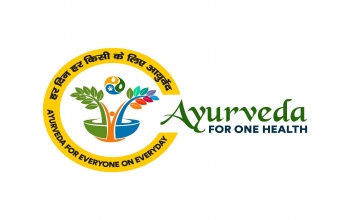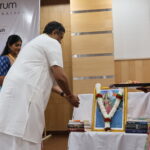
– Dr Shubhamangala Acharya, Media coordinator, Agnivesha Ayurveda Anushtana
We are celebrating Ayurveda day for past eight years under the guidance of ministry of Ayush and our beloved prime minister Sri Narendra Modi. World Ayurveda day is selected on the day of Dhanteras. This is the birth anniversary of lord Dhanvantari who is worshipped as God of Ayurveda. The first Ayurveda Day was celebrated on 28 October 2016. This year the 8th Ayurveda day falls on 10th November, 2023.
The Ministry of Ayush choses different themes every year for the Ayurveda day, to address different health issues through Ayurveda. Various programs on the theme selected are conducted throughout the country covering millions of people. This helps in generating awareness among people about the health issue as well as the potential role of Ayurveda in prevention and treatment of the issue.
This year the theme is in alignment with the theme of India’s G20 Presidency ‘Vasudhaiva Kutumbakam’, and the focal theme for Ayurveda day-2023 has been decided as ‘Ayurveda for One Health’ with Tag line ‘Ayurveda for everyone on every day’ focusing on human-animal-plant-environment interface.
Ayurveda, like any other Indian philosophy, is in harmony with the nature. In Charaka Samhita loka purusha samya- acharya Charaka explains that the various entities present in the universe are present in the individual too. The universe and humans are having similar composition. Further he explains that both are formed by five elements (earth, water, fire, air, space) and Chetana or consciousness. The famous quote from our vedic literature also explains the same” yat pinde tat brahmande (human being and cosmos are similar)

The theme this year is focused on three main fields: Ayurveda for Farmers, Ayurveda for Students and Ayurveda for Public. Ayu means life or lifespan, and veda means science. According to Acharya Charaka, the science which changes an unhealthy life (ahita) to a healthy life (hitaayu) and from a miserable life (dukhaayu) to a pleasant life (sukhaayu) is Ayurveda. Ayurvedic science deals not just with humans but also with plant health (Vrukshaayurveda), Elephant wellbeing (hasti aayurveda) etc.
Ayurveda for Farmers-
The farmers are the back bone of our society. We can educate them about the basic medicinal plants which they can grow to maintain their health and the potential to grow different Ayurvedic herbs organically to sell since these herbs are in high demand in the ayurvedic pharma industry. We should create awareness amidst them on how variety of plants can grow together in the field. The following significant medicinal plants are always in full demand. Some of them are; Indian Barbery, Licorice, Bael, Isabgol, Guggal, Chandan, Long Pepper, Brahmi, Jatamansi, and Madhunashini, Kalmegh, Satavari, Ashwagandha, Chirata, Katki, Shankhpushpi, Ashoka, Giloe, kokum etc. Before cultivation of any of the plants, farmers should have the proper knowledge about the habitat of these plants.
Another important project is creating awareness among farmers about the indigenous cow breeds which are native to India. The major desi cow breeds are Gir, Ongol, Sahiwal etc. One must educate the farmers on how the cow’s manure can help in organic farming and health benefits of the milk, ghee and gomutra (urine) of desi cows. The Panchagavya which contains desi cow’s milk, ghee, curd, urine and cow dung is a proven medicine for some of the chronic diseases like certain types of cancers, tumours etc. Farmers play an important role in creating a healthy society.
Ayurveda for students-
The health of the Young is vital and crucial for the development of the nation. Most young people are presumed to be healthy but as per WHO, an estimated 2.6 million young people aged 10 to 24 yrs die each year and a much greater number of young people suffer from illness ‘behaviours’ which hinder their ability to grow and develop to their full potential. Nearly two-thirds of premature deaths and one-third of the total disease burden in adults are associated with conditions or behaviours initiated in their youth (e.g., tobacco use, physical inactivity, high risk sexual behaviours, injury and violence and others).
Educating the students about the Ayurvedic dinacharya (daily routine) which includes waking up early, applying oil to the body, proper exercise, yoga and healthy Ayurvedic diet plan and sadvrutta (good conducts for mental wellbeing), will help in their physical as well as their mental health wellbeing. The quality of their life improves and helps them with long term health benefits. Waking up at Brahmi muhurta (around 40 minutes before sun rise) will keep the mind fresh and helps improve concentration due to the availability of the high oxygen in the environment. It is the best for adhyayana or studies. Abhyanga or oil application to the body before bath can help in improving the sleep, calmness of mind besides improving the complexion.
Regular exercise like yoga and pranayama improves the concentration, removes stress and lethargy. Healthy diet practices like adding ghee in the food, home cooked traditional food, use of ginger, cumin, ajawayn etc. helps in good metabolism. Herbs like Brahmi in the form of chutney will act as brain tonic. These practises will help in overall development of the student’s life and keeps them away from addiction and anxiety. The mentally stable and physically young generation is the great asset to a nation.
Ayurveda for general public-
In educating the public, the department of Ayush and other organisations in Ayurveda and yoga sectors are conducting various awareness programs. Here our main aim should be to create awareness about healthy life style which can prevent the non-communicable diseases like diabetes, hypertension etc which are drastically increasing in our society irrespective of age group. Bringing awareness about ayurvedic diet plan according to the prakruthi(constitute) of the person and removing the fear of the disease, can improve the general immunity. The importance of good appetite or Agni in preventing the illness must be explained. Educating about Dinacharya as mentioned earlier, Rutucharya (lifestyle changes according to the seasons) can also provide long term health benefits to the public. Our festivals are connected with healthy practises, e.g. the practise of oil massage to the body and having sweets prepared with ghee during Deepavali can protect us from cold and dry weather of early winter (Hemantha). By knowing these facts people should be encouraged to adopt these changes in their day-to-day life.
Main aim of Ayurveda is swastasya swaastya rakshanam which is to maintain the health. Aturasya vikara prashamanam ie treating the disease of the un healthy person comes only as a follow up. Initial chapters of all Ayurveda samhitas have clearly explained the methods like daily and seasonal life style changes, following of certain good conducts, food according to the places we live etc. We can say confidently that the most scientific knowledge about health has been given to us through Ayurveda thousands of years ago and we need to understand and preserve this treasure trove of knowledge for the benefit of the mankind.





